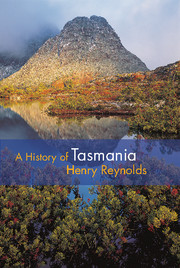Book contents
- Frontmatter
- Contents
- Illustrations
- Acknowledgements
- Introduction
- 1 First Meetings, Extraordinary Encounters
- 2 Van Diemen's Land: Settling in the enviable island
- 3 The Black War: The tragic fate of the Tasmanian Aborigines
- 4 An Indelible Stain?
- 5 The Triumph of Colonisation
- 6 The Politics of Van Diemen's Land
- 7 The Convict System
- 8 Post-penal Depression, 1856–70
- 9 Reform and Recovery
- 10 Federation and War
- 11 Between the Wars
- 12 Postwar Tasmania
- 13 Towards the Bicentenary
- Notes
- Sources
- Index
8 - Post-penal Depression, 1856–70
Published online by Cambridge University Press: 05 April 2012
- Frontmatter
- Contents
- Illustrations
- Acknowledgements
- Introduction
- 1 First Meetings, Extraordinary Encounters
- 2 Van Diemen's Land: Settling in the enviable island
- 3 The Black War: The tragic fate of the Tasmanian Aborigines
- 4 An Indelible Stain?
- 5 The Triumph of Colonisation
- 6 The Politics of Van Diemen's Land
- 7 The Convict System
- 8 Post-penal Depression, 1856–70
- 9 Reform and Recovery
- 10 Federation and War
- 11 Between the Wars
- 12 Postwar Tasmania
- 13 Towards the Bicentenary
- Notes
- Sources
- Index
Summary
In the colony’s short history 2 December 1856 was a big day. It was the moment when the recently arrived Governor Henry Fox-Young opened the new parliament. The 30 recently elected members of the House of Assembly and the 15 legislative councillors took their seats in the council chamber watched by what the Launceston Examiner called ‘between 60 and 70 of our most influential colonists’ as well as a ‘large number of ladies…The scene,’ the paper declared, ‘was brilliant and worthy of the occasion.’ Despite its distinctive history as a penal colony the island had travelled in the wake of the mainland colonies – New South Wales, Victoria and South Australia – and accepted responsibility from the imperial government for its own internal affairs. It was a decisive constitutional change, and one of global significance. From the first day of 1856 the tainted words ‘Van Diemen's Land’ were officially replaced by the new name, Tasmania, a change sanctioned by the queen in an Order in Council issued on 21 July 1855.The governor, as the queen's representative, with words appropriate for the first day of the Tasmanian parliament, declared:
At the first meeting of an entirely elected Parliament I perform a very gratifying duty. I congratulate you, and through you the Colonists at large that Tasmanian freedom has passed from a name into a reality, since it is now guaranteed, not by positive laws merely, but by the enduring bulwark of free popular institutions.
- Type
- Chapter
- Information
- A History of Tasmania , pp. 164 - 186Publisher: Cambridge University PressPrint publication year: 2011



